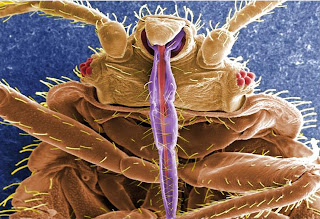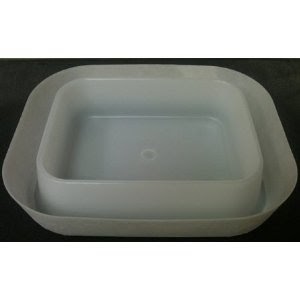 |
| Bed Bug |
Why are bed bug traps important? The Centers for Disease Control and the Environmental Protection Agency have issued a Joint Statement addressing the growing number of bed bug infestations in the United States. A key recommendation was for an integrated pest management (IPM) approach that would not rely too heavily on chemical sprays and fumigants. Although not stated as such, it is obvious that bed bug traps should be an integral part of this approach. The bed bug traps approach also has the advantage of providing a monitoring capability. For example, in the case of a severe infestation that necessitates the use of pesticides, it is likely that a small number of bed bugs will survive and will eventually reproduce. According to the Joint Statement, some populations of bed bugs are resistant to insecticides – even to DDT! Nonetheless, if bed bug traps are implemented as a follow-up to chemical application, then any surviving insects can not only be monitored, but trapped. Thus, the use of bed bug traps will not only reassure the homeowner, but in the end will be the final solution. The purpose of this bed bug traps review is to give the homeowner clear, up-to-date information concerning bed bug traps.
Note: Many homeowners prefer to use organic insecticides that are offered as a safer alternative to synthetic bed bug killers. These commercial products are usually a mixture of natural compounds such as eucalyptus or cedar oil among other things. However, these compounds are more accurately described as repellants rather than insecticides. More than one homeowner has reported finding a live bed bug and spraying it directly with a very expensive and smelly organic insecticide, only to watch the bug continue merrily on. Nonetheless, organic insecticides, if used frequently and at a fairly high dosage will drive bed bugs away or at least into a deep crevice or corner.
Bed Bug Traps Review
The homeowner has essentially two choices for bed bug traps: Homemade devices and commercial traps. Homemade bed bug traps in many cases are very effective. In fact, commercial traps sometimes use the same methodology as commercial traps. For example, homemade traps often utilize a source of carbon dioxide or heat or sometimes both. Bed bugs are drawn into the trap, just as if it was a human that was producing the carbon dioxide and heat. Once inside, the bed bugs are captured, immobilized, or killed. Capture typically occurs by allowing the insect to fall into a well that has a slick surface that prevents them from escaping. Immobilization usually involves a sticky surface that truly immobilizes the insect. Killing is often done by the use of diatomaceous earth which penetrates the exoskeleton of the insect and kills it. The problem with homemade traps is not efficacy – they actually work - it is more a question of convenience and cost. If one uses dry ice as a carbon dioxide source or a heating pad as a heat source, then the cost of a homemade trap can easily exceed the cost of a several commercial traps. From the “bed bug traps review” standpoint, we advise the homemade approach only if you simply prefer to build things for yourself.
In a previous post, we discussed a new method for trapping bed bugs, specifically the use of scents that mimic the smell of bed bug feces. Unfortunately, a commercial product based on the British research is not yet available. There are, however, two products that have been proven effective. Like the homemade traps described above, both products work on the principle of a lure combined with a trap.
The first product, ClimbUp, as the name suggests, traps bed bugs as they climb up to the lure, which is guess what? You! The traps are set under each bed post and the bed bugs fall into the trap as they attempt to reach the source of the carbon dioxide and heat. As scary as that sounds, the ClimbUp traps are very effective. It is impossible for the bed bugs to reach you although care must be taken to keep bed covers from touching the floor and the headboard must be placed away from the wall. The only complaint is that the plastic cups will crack if you have carpeting. However, users report that by placing a thin board (some use metal electrical plating) under each bed post, the plastic cups do not have to bear the entire weight of the bed and the problem of cracking is solved. ClimbUp XL Bed Bug Traps are available for beds with large feet. Users are ecstatic when they awake in the morning with no bed bug bites and a quick inspection reveals either no bed bugs in the traps or they find an individual bug or two, desperately trying to escape. One of the main purposes of bed bug traps is to provide peace of mind and the ClimbUp traps do exactly that. |
| Order ClimbUp Traps |
 |
| Order BuggyBeds |
Bed bug traps review also recommends BuggyBeds. Buggy Beds are glue traps that contain a substance that supposedly mimics human hormones. The actual ingredient is not disclosed, but users rave about their experience with BuggyBeds. These traps are perfect for traveling. Small and easy to install, you simply place them between the mattress and the box springs of the bed. As you may know, many bed bug infestations actually originate in a hotel. Stay in an infested hotel (even upscale hotels have bed bugs) and not only do you get bitten, but there is a good chance that you will bring bed bugs home with you. A good tip for travelers: Never put your suitcase or clothing on a hotel bed – you could easily get stowaway bed bugs. Many travelers will install BuggyBeds immediately after they check into their hotel room and then leave for a while. (Turn the lights off before your leave.) When you return to your room, immediately check the BuggyBeds and if there are any bugs, take your BuggyBeds to the hotel desk and insist on a new room. Management is usually embarrassed and very accommodating, especially when you present them with the evidence!
Advisory note: BuggyBeds and ClimbUps have received positive reviews by users. Be aware that if there is a severe infestation, even the best product may not trap every bed bug. In future posts, we will discuss the experiences of users of these products as well as some other products. Good luck!

+(145x150).jpg)


